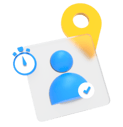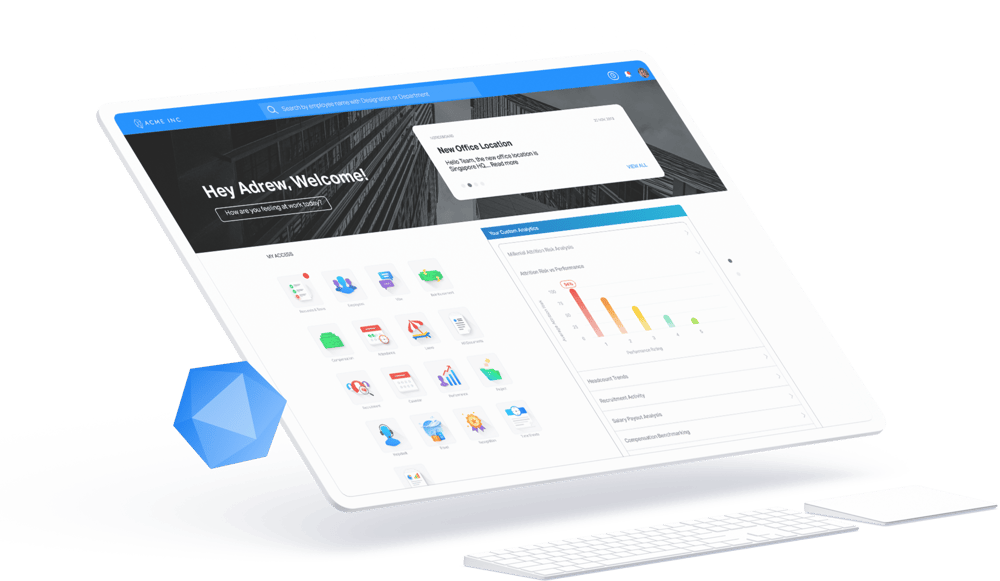HRMS | Singapore Limitless Possibilities, a Single Integrated HRMS
✨Ideal for Enterprises with 200+ Employees✨
Achieve HR excellence faster and smarter with Darwinbox, the new-age, mobile-first HRMS suite for enterprises. Automate HR processes, simplify interactions, gain actionable insights, and build better workplaces. Experience the power of Darwinbox now!
900+
Enterprises
2.5 Million+
2.5 Mn+
Employee
130+
Countries
900+
Enterprises
492k+
Interviews Scheduled
140+
Offer Letters Generated
130+
Offer Letters Accepted
Take A Darwinbox Product Tour
Take a Product Tour
Join our growing list of customers
900+ Enterprises Are Saving Time and Boosting Productivity With Darwinbox
Darwinbox genuinely listened to our needs from an experience and systems standpoint. We really appreciate this level of customer-centricity as an organization, because it is one of the key enablers at JG Summit as well, and it's great to share that value with a partner.

Guly Go CHRO Gokongwei Group
We wanted our people to grow at the same pace as our business and needed the flexibility to do most of the HR functions by ourselves. With Darwinbox, we could achieve that because it is intuitive and so easy to use.

Tri Anggoro CHRO STP Tower
Turning to Darwinbox Helpdesk has helped us automate our processes, plug the gaps, and create a streamlined process. The spare bandwidth has helped us take up initiatives to support the business and create a refined employee experience.

Izzat Jamal Head of People and Transformation Socar
Our CEO is paying attention too. I can see him engaging on the Vibe posts that come up. To see that posts are getting that kind of visibility sends a clear message to the employees and really promotes the kind of culture we want to build. It encourages others to recognize their peers, and I can see this happening across teams and even across geographies.

NICOLE POON HEAD HR MATCHMOVE
Refreshing to see a HRMS software which is simple, intuitive and easy to navigate. We wanted technology to work for us and make our processes more robust. The platform provided us the flexibility to build modules customized to our internal requirement.

Sohini Dutt Director & Head of Human Resources Nivea
Go truly Mobile!
Embrace #MobileFirst Transformation and empower your organization with our web applications on mobile. Enhance speed, efficiency, and convenience as employees access information on the go. Stay informed and connected anytime, anywhere. Join us now!
Manager View
- Check the status of the reportee's work and daily check-ins.
- Act on duties and approve or reject requests.
- View, update, and approve goal plans
- Evaluate reportees and provide feedback immediately
- Accept offer letters, monitor candidate progress, and provide interview evaluations
Employee View
- Voice-activated universal search
- Daily Clock In/Out (with Geotagging and Facial Recognition)
- View paychecks, tax forms, HR correspondence, and policies.
- Performance management for mobile platforms and ongoing feedback
- OCR receipt scanning for expense tracking
- Task management that is seamless and one-click actions
Why Do Leading Enterprises Choose Darwinbox?
Enables Various Methods of Working
Manage any combination of new working modes, whether it be work from home or staggered office arrival.
User Experience That Is Intuitive
Optimize end-user experience and boost employee adoption with our mobile-first platform designed for maximum effectiveness. Drive higher adoption rates and experience the best-in-class mobile platform now!
Rapid implementation
Designed to get you up and running in 15 days or less so you don't miss out on real-time context.
Seamless Integrations
Our platform was created using open APIs so that it may be integrated with any other organization-wide systems that are already in place.
Highest Levels of Data Security
Our platform is designed to protect your data and complies with some of the strictest and most well-known standards in the world.
Adapting & Improving
Get the most recent upgrades and improvements to our product every four weeks to stay on top of technology!
Recognized by Industry Analysts and Leaders
Could Darwinbox Become The Next Workday?
Josh Bersin, Global Industry Analysts & CEO of The Josh Bersin Company
The great thing about Darwinbox is that it enables employees and employers to be productive and impactful as they can be
Jessica Neil, ex-CHRO Netflix
FAQs
In the context of Human Resources, HRIS stands for "Human Resource Information System," and HRMS stands for "Human Resource Management System." While both terms are related to HR technology, they have distinct differences.
HRIS (Human Resource Information System): HRIS is primarily focused on managing and organizing employee data and information. It serves as a centralized database that stores essential HR-related data, such as employee profiles, contact details, job history, salary information, benefits, and more. HRIS provides a secure and efficient way to access and update employee information, facilitating administrative tasks and record-keeping. However, HRIS may not always include advanced features for managing other HR processes like payroll, leave management, or performance evaluations.
HRMS (Human Resource Management System): On the other hand, HRMS is a more comprehensive system that encompasses the functionalities of an HRIS and goes beyond it. In addition to managing employee information, HRMS includes various modules and tools to handle a wide range of HR processes. These may include payroll processing, time and attendance tracking, leave management, performance management, recruitment, onboarding, training, and more. HRMS provides end-to-end solutions for managing the entire employee lifecycle and optimizing HR workflows. It often offers automation and analytics capabilities, enabling HR professionals to make data-driven decisions and improve overall HR efficiency.
In summary, HRIS is primarily an employee data management system, while HRMS is a more comprehensive HR solution that includes various HR process management capabilities. When choosing between the two, organizations in Singapore need to assess their specific HR needs and decide which system aligns best with their requirements and business objectives.
HR software, also known as Human Resources software, is a powerful tool designed to streamline and optimize various HR processes within an organization. It serves as a comprehensive platform to manage and automate a wide range of human resource activities. In Singapore, HR software is widely used by businesses and companies to improve HR efficiency and enhance employee management. Here are some key purposes and uses of HR software:
Employee Data Management: HR software helps in organizing and maintaining essential employee data, including personal information, job history, contact details, and more. It serves as a centralized database for easy access and updates.
Payroll Processing: HR software facilitates seamless payroll management, calculating employee salaries, deductions, and bonuses accurately. It ensures timely and error-free payment to employees in compliance with local regulations.
Attendance and Leave Management: The software helps track employee attendance, working hours, and leave requests. It automates leave approvals and ensures accurate attendance records.
Performance Management: HR software provides tools for setting performance goals, conducting performance appraisals, and tracking employee progress. It assists in identifying areas of improvement and recognizing top performers.
Recruitment and Onboarding: HR software streamlines the hiring process, from posting job openings to candidate screening and interviews. It also helps in managing the onboarding process for new employees.
Training and Development: The software facilitates employee training and development programs, tracking training progress, and assessing the effectiveness of learning initiatives.
Compliance and Reporting: HR software helps in maintaining compliance with labor laws and regulations in Singapore. It generates reports and analytics for HR metrics and insights.
Employee Self-Service: Many HR software solutions offer employee self-service portals, allowing employees to access their information, update personal details, apply for leaves, and view pay statements.
Talent Management: HR software assists in talent acquisition, talent retention, and succession planning. It aids in identifying and nurturing high-potential employees.
Streamlining Workflows: Overall, HR software automates repetitive tasks, reduces paperwork, and streamlines HR workflows, enabling HR professionals to focus on strategic initiatives and employee engagement.
In conclusion, HR software is a valuable tool for managing various HR functions, enabling organizations in Singapore to improve HR efficiency, enhance employee experiences, and drive business success.
HRMS, which stands for "Human Resource Management System," is a comprehensive software solution designed to streamline and optimize human resource processes within an organization. In Singapore, HRMS plays a crucial role in enhancing HR efficiency and employee management. Here's how HRMS works:
Data Centralization: HRMS acts as a centralized repository that stores all essential employee data and information. This includes personal details, job history, contact information, qualifications, skills, performance records, and more. Having a single source of truth for employee information simplifies HR tasks and ensures data accuracy.
Employee Self-Service: Many HRMS platforms offer employee self-service portals. Employees can access the system to view and update their personal information, apply for leaves, check payslips, submit expense claims, and request HR-related services. This empowers employees and reduces the administrative burden on HR teams.
HR Process Automation: HRMS automates various HR processes, including payroll processing, attendance tracking, leave management, and performance appraisal. Automation reduces manual work and ensures accuracy, saving time and effort for HR professionals.
Payroll Management: HRMS facilitates seamless payroll processing. It calculates employee salaries, bonuses, taxes, and deductions accurately, taking into account factors such as overtime, leaves, and benefits. It also generates payslips and handles statutory compliance with Singapore's payroll regulations.
Attendance and Leave Management: HRMS tracks employee attendance, working hours, and leave requests. It automates leave approvals and ensures accurate attendance records, assisting in payroll calculations and compliance.
Performance Management: HRMS provides tools for setting performance goals, conducting performance appraisals, and providing continuous feedback to employees. It helps in identifying top performers and areas for improvement, contributing to employee development.
Recruitment and Onboarding: HRMS streamlines the recruitment process, from job posting and candidate screening to interview scheduling and offer management. It assists in managing the onboarding process for new hires, ensuring a smooth transition into the organization.
Training and Development: HRMS supports employee training and development initiatives. It helps HR professionals create and manage training programs, track employee progress, and assess the effectiveness of training efforts.
Reporting and Analytics: HRMS generates various reports and analytics on HR metrics, employee performance, attendance, turnover rates, and more. Data-driven insights enable better decision-making and strategic planning.
Integration and Scalability: HRMS can integrate with other systems, such as accounting software and CRM tools. It can scale to meet the growing needs of the organization as the workforce expands.
In summary, HRMS works by providing a unified platform for managing employee data, automating HR processes, and supporting decision-making with data-driven insights. It empowers HR teams, enhances employee experiences, and enables organizations in Singapore to effectively manage their human resources, leading to improved efficiency and productivity.
Location - India | USA | Philippines | Singapore | Malaysia | Indonesia | Dubai | Thailand
Copyright © . Darwinbox Digital Pvt. Ltd. All Rights Reserved.



.png?width=690&height=800&name=2%2c3%201%20(1).png)




